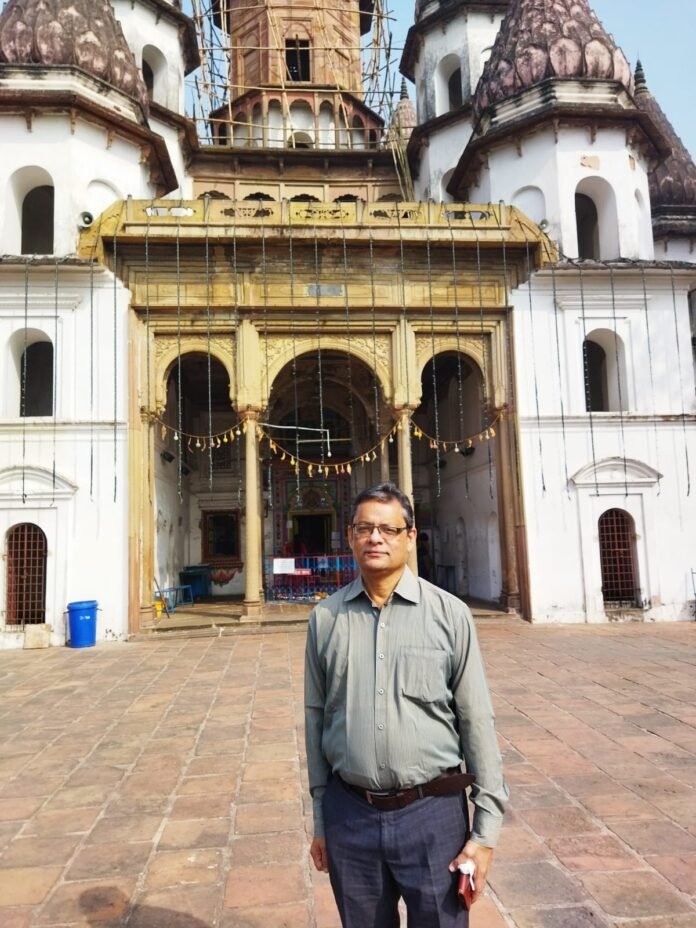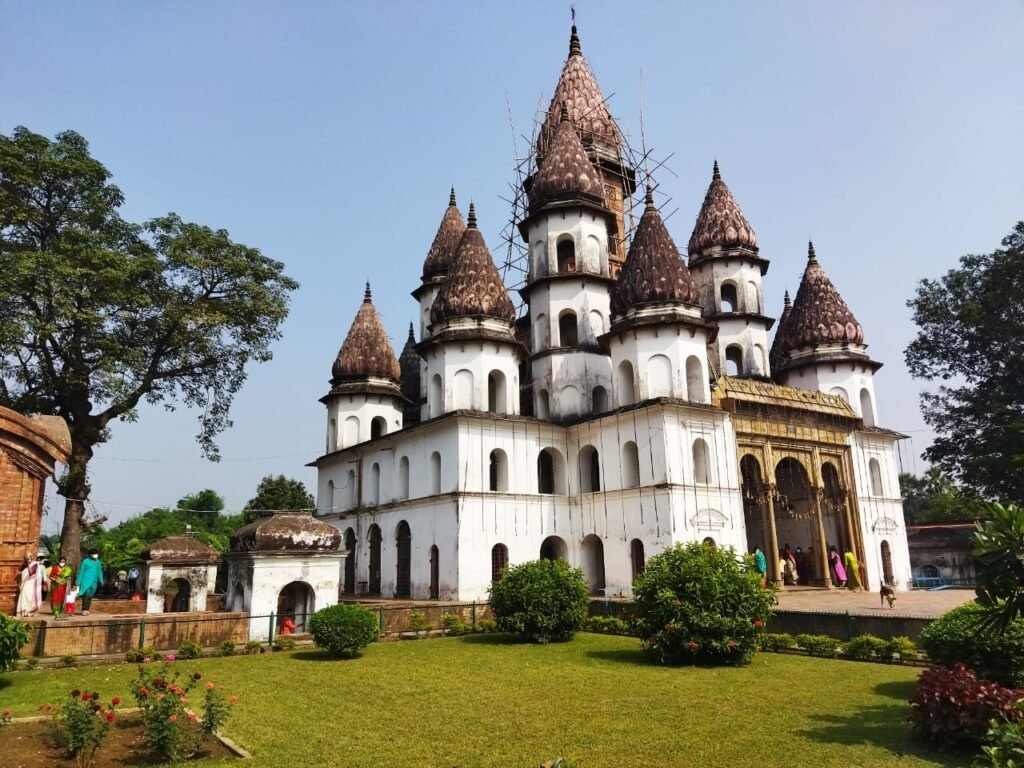
Visit Hanseswari Temple : 2021

It is the month of December. But winter is, as yet, not so intense.
Winter is my favorite season for outings. So last Saturday, Saikat ‘my son and I went out for a ride on a bike to the legendary Hanseswari temple, ‘famous for the live deity of Hanseshwari Devi.
Situated in Bashbaria of ‘Hooghly district, the Hanseswari temple opens at 6 am and closes at Noon and again from 4 pm to 6-30 PM. Bashbaria is about twenty kilometers from my hometown of Chandannagar. Bashbaeria was a fortified town during the Mogul period.
Journey Begins
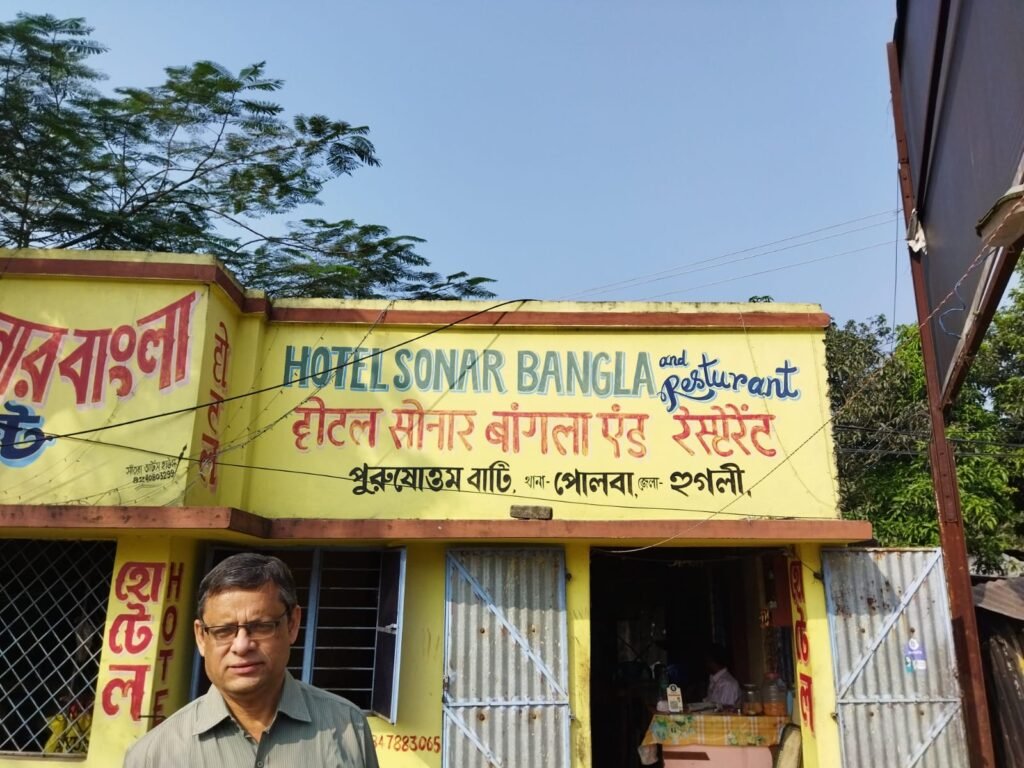
We set out for the temple around 7 am on our 180 cc-powered Bajaj Pulsar bike along the national highway no. 6 (Delhi road).
The cool breeze with the pale wintry sun peeping through the floating clouds, and the greeneries alongside the highway, thrilled us to bits
Saikat drove up at a moderate speed to reach Hanseswari temple in an hour (around 9 am). Of course, the period included a brief stopover at a roadside eatery for tea and Chola’ batora for breakfast.
Reaching Hanseswari temple and feelings at first sight
As I reached Hanseswari Mandir, I was awe-struck by its spiritual beauty and architectural grandeur. However, a cursory glance from the outside made me feel that the temple structure, to a degree, has a bit of a resemblance to Russian and Dutch architecture.

The five floors of the temple narrowed ascetically from bottom to top. In other words, the shrinkage of the area from the ground floor to the top floor is perceptible when you look up at the temple.
The temple has thirteen ‘Minars.’ Eight in the periphery, four inside the peripheral frame, and one in the middle. The construction features of the temple made me feel it is unique in architecture.
People in or around the temple told me that the five-storied lotus-shaped temple depicts five parts of human anatomy. The principle of Tantra philosophy forms the basis of the temple’s construction.
I also frankly admit to my Unveil. Press readers that neither have an iota of tantric philosophy (in Hindi tantra shastra) in me nor much do I know about archaeology or architecture. Still, as an ordinary man, I was incredibly impressed at the very sight of the temple from its outer look itself.
Raja Nrisinghadev, a descendant of the royal family of Banshberia, started the construction of this temple in 1799. But he died before the completion of the temple. His second wife, Sankari Devi, completed her husband’s unfinished temple in 1814. Nrisangadev, in the latter part of his life, turned into Tantrik.
Observations during Hanseswari temple’s visit
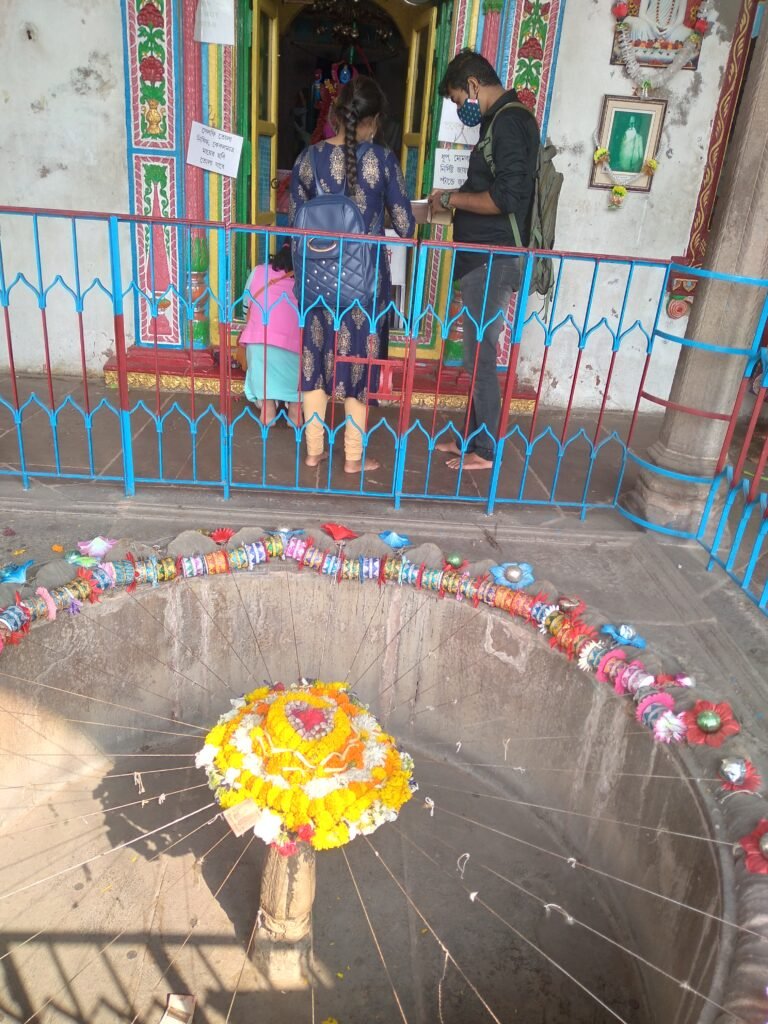
When I entered the temple premises, my attention caught on a cavity, projecting out an elongated brown-colored cemented structure with perforated tips. Covering its top were bunches of colorful flowers.
I mistook it for a Shiva-ling. So I was a bit amused when the temple maintenance in-charge, Pratap Singh, told me it was not a shiva-ling but a defunct fountain of olden days. “In those days, there was no motor. Instead, water from a tank flowed through a pipe to make the fountain work. But now, it does not function. Flower decorations give it an aesthetic look,” said Pratap.
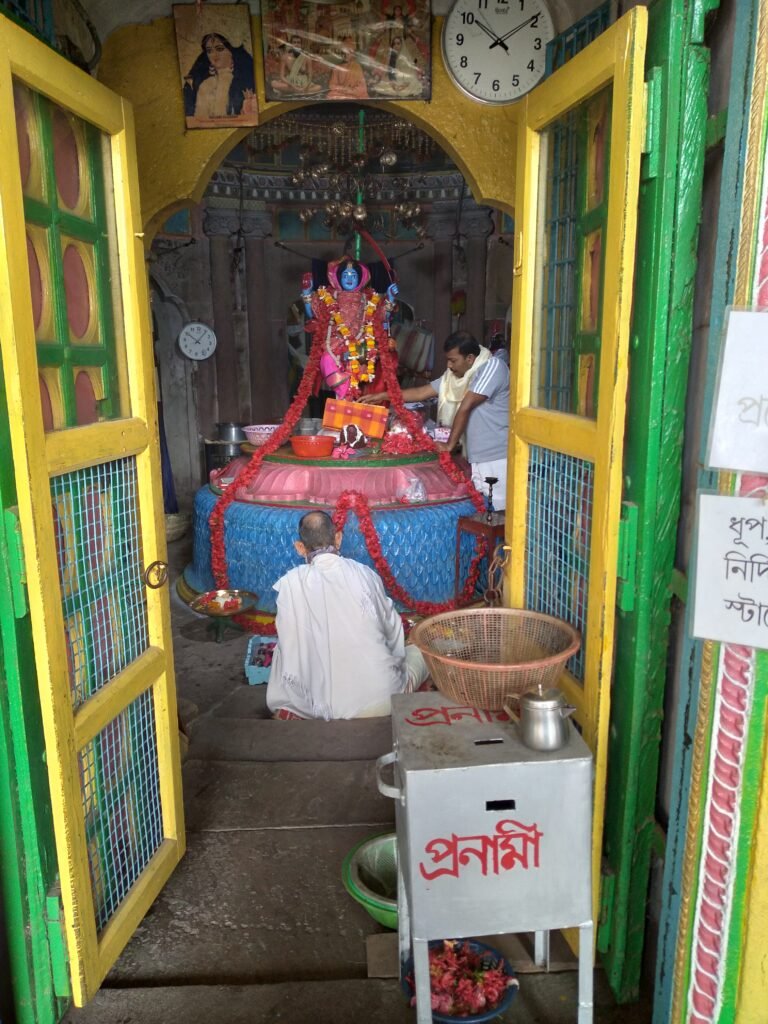
As I moved forward nearer to the temple’s central room, I got engrossed by seeing a big circular altar made of stone on which resides the luminous divine mother, Hanseswari. The Lotus carries the blue neem-wood idol of Hanseshwari. A chalky white-colored Lord Shiva made of stone lies supine on the altar’s surface. A Lotus has come out of his heart on which the four-armed mother Hanseswari is seated. The deity is with three eyes.
The artwork of the temple’s central room and its outside and the liveliness of Hanseswari Devi attracted the people. A framed picture of Nrisinngadev could also be seen on the outer wall of the deity room.
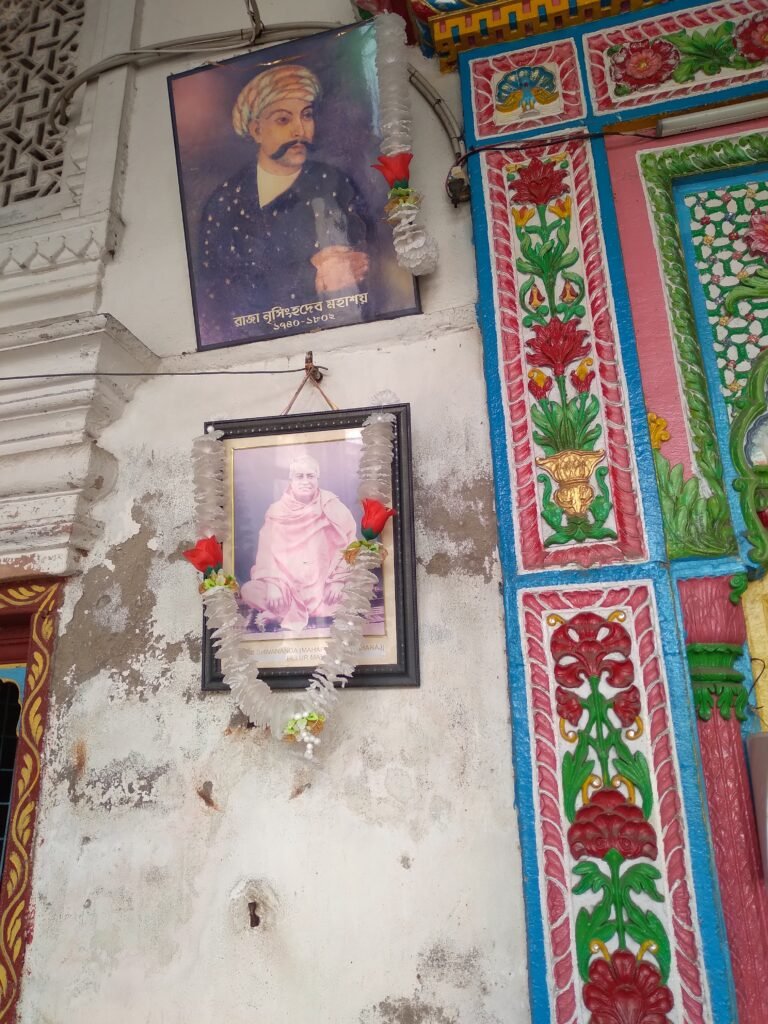
A rectangular veranda on the ground floor encompasses the entire temple. There are twelve black stone Shiva-lingas in twelve rooms around the veranda. Each Shiv-linga is at the base point of the room. Unfortunately, the entry doors of the rooms were locked.
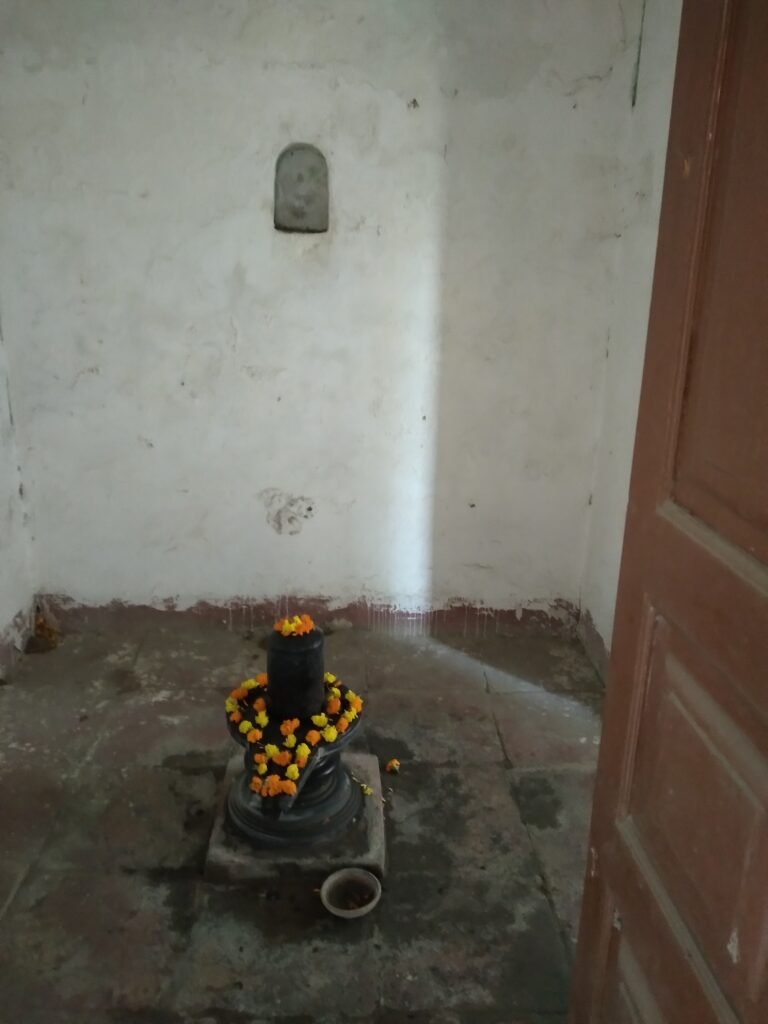
However, you can view the Shiv-linga from the grilled door. In addition, you may click photographs without obstruction to the grill by inserting your mobile camera inside into the grill. There are twelve shiv-lings on the ground floor plus a white-colored Lord Shiva at the temple’s altar in the central room.
During my informal chat, Pratap Singh and a volunteer (Swechha Sevi) of the temple told me that there is a white Shiva-ling on the third floor apart from this. “So in total fourteen Shiva and not thirteen,” said Pratap Singh while correcting me.

“No, you cannot go to the third floor. It is not open to visitors. There are official restrictions. Moreover, the upper part of the building is not in good shape. Maintenance work is also going on. The priest only goes there in the morning for rituals and our maintenance people for cleaning purposes. For each floor, there are separate staircases. There is no common staircase as it would be in a normal building. There is some ascetic and tantric perception for designing separate staircases for each floor,” Pratap said.
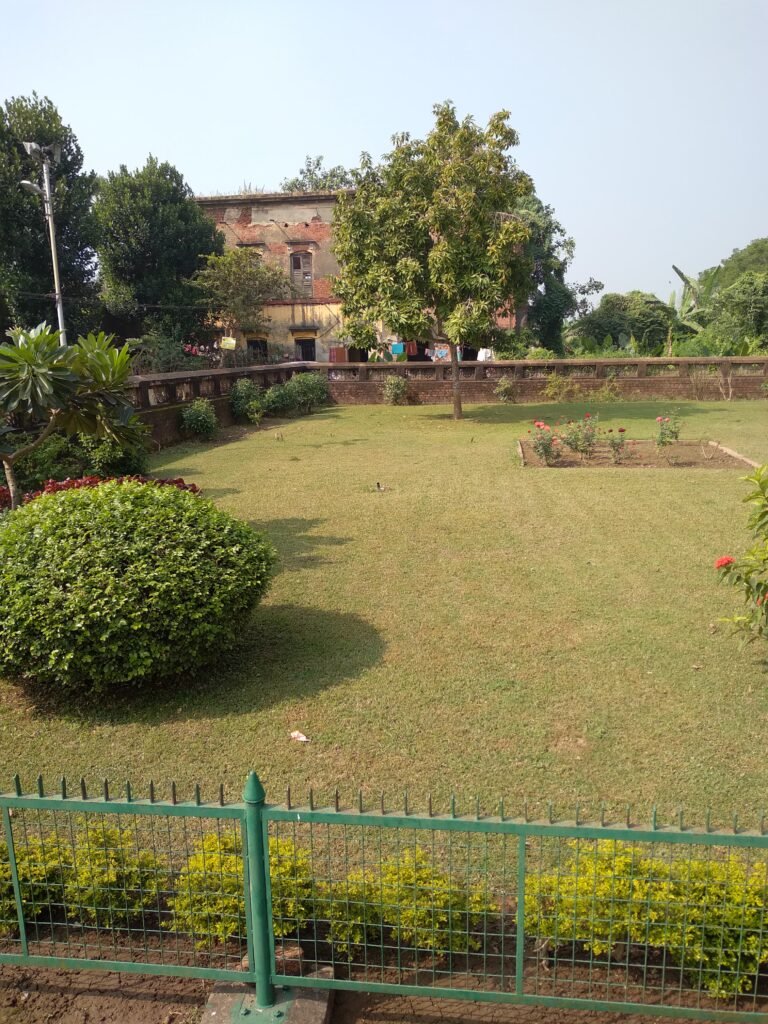
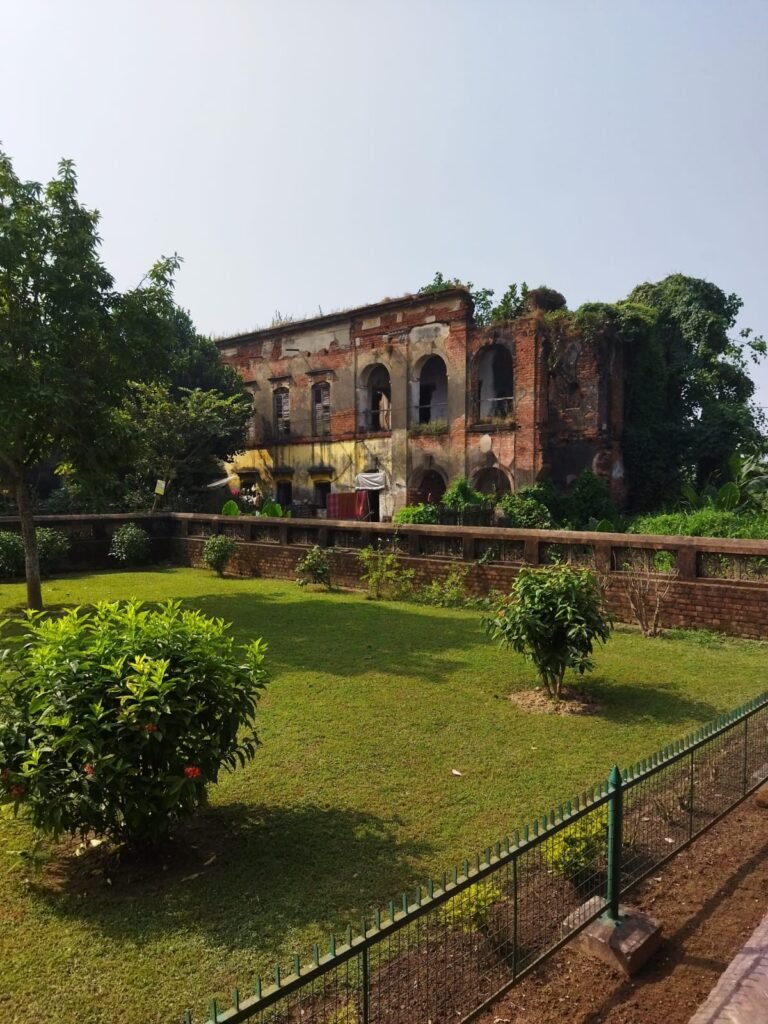
There are two moderate-sized green lawns on the temple’s front and back sides.
Mythology ,History and Fate of Royal Family
But I was more curious to know the mythology and history related to the temple. Fortunately, I came across Budhendu Ray, who claimed himself as a descendant of the royal family (refer to the family chart of the royal family at the end of the story), and temple priest Basant Kumar Chatterjee
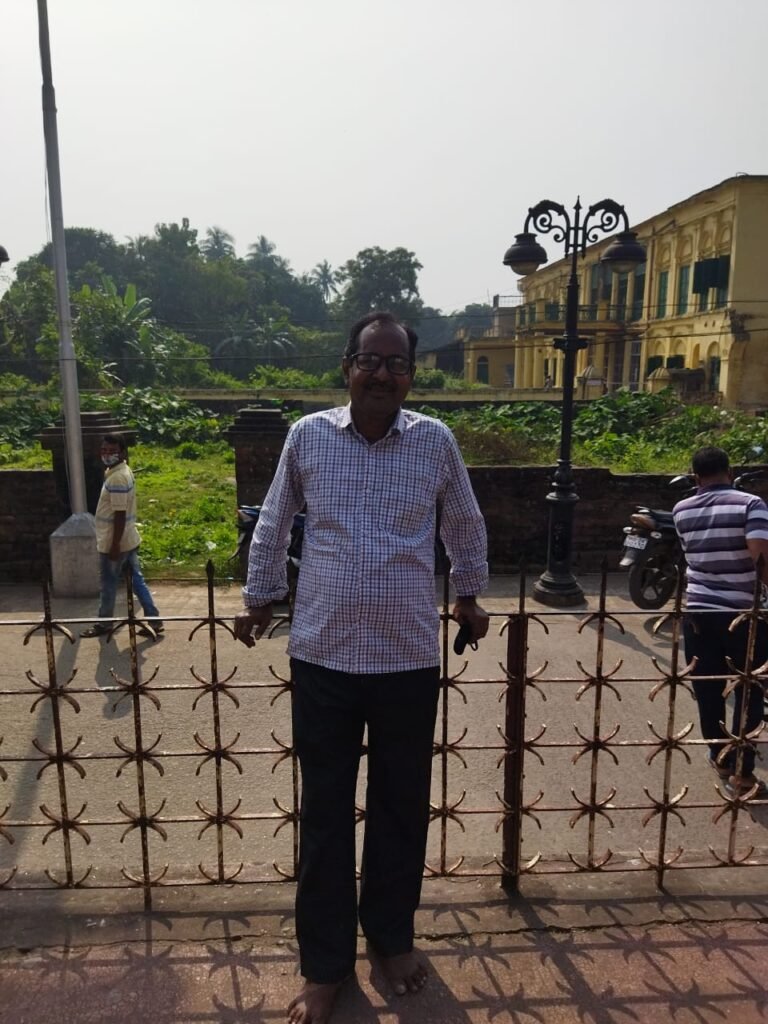
They said that Devi Hanseswari is a form of Dakshina Kali. (Dakshina Kali means idol of Kali facing south). But Devi Hanseswari does not look like the traditional Goddess Dakshina Kali.
Unlike the angry face of classic Dakshina Kali, the divine mother Hanseswari always appears calm with a smile on her face except for the night of Kalipuja.
On the night of Kali Puja, by insertion of a mask into the front of the idol of Hanseswari, it takes the shape of a primordial Kali, i.e., a frightening face with loose teeth and a lolling tongue.
Temple Priest said many people have a presumption that Nrisinghadev had named the idol as ‘Hanseswari’ after his mother’s name. But his mother was Satyasundaridevi. Hanseswari means knowledge of eternity. “Nrisinghadev called the idol Hanseswari with a Tantrik perspective,” opined one of my co-visitor.
In November 1791, Nrisinghadev went to Kashi for a meditation/Tantra Sadhana. At the pinnacle of the sadhana, the divine mother Devi Hanseswari appeared in his vision on a Lotus. She desired a temple as described in the central room of the temple.
The aesthetic Nrisinghadev, while returning from Kashi to Bansbaria, filled up a dozen boats with stone and other materials for building the temple and required skilled artisans. He also brought a log of Nim tree-wood by toeing with the ship to shape the idol of mother Hangseswari. Finally, he drew the picture of the proposed temple in his meditative vision for ease of construction by artisans.
Unfortunately, Nrisinghadev died in 1799 before the completion of the temple. However, his second wife, Shankari Devi, completed her husband’s unfinished work in 1814.
.On delving through some digital documents and books and interacting with the local people of Bansbaria, it emerged that Raja Nrisinghdev was a scholar, well versed in scripture, a genius at drawing, and a versatile singer. His aesthetic sense was inborn.
But he had a turbulent childhood. His father, King Govindadev Ray, met an untimely death in October 1740. Nrisinghdev was then in his mother’s womb. The rule of that time says that if a Zamindar died without leaving a male issue, then another Zamindar could occupy the former’s whole property. So Govindadev, when he breathed his last in October 1740, was issueless as Nrisinghadev was born in December 1740.
Nawab Alivardi Khan was then the Nawab of Bengal (Period: 1740-1756), and at Burdwan, there was Chitrasen Ray, the zamindar of Burdawan. Chitrasen Ray was the son of Late Kirtichand Ray.
It is said that Kirtichandra, in a particular incident, once saved the life of Nawab Alivardi Khan. So the Nawab was indebted to him and looking for a repay.
Although Chitrasen knew about the conceiving of queen Satyasundari Devi and the birth of Nrisinghdev, he concealed the truth and communicated to Alivardi Khan that Raja Govbindadev Roy died issueless.
Alivardi Khan was waiting for an opportunity to favor Burdwan Zamindar. So immediately, Nawab Alivardi Khan passed an order to give possession of the whole property to Chitrasen Ray. Furthermore, on the other side of Ganga, Raja Govindadev Ray’s Halda territory was captured by Raja Krishna Chandra Roy and passed to his son Shambhuchandra,
For queen Satyasunndaridevi (‘widow, royal wife of the Late Govindadev Roy’), it was a moment of untold miseries. Still, she did not bow down in the hours of crisis and looked forward to bright days ahead, pinning all hope on her son.
Nrisinghadev had to face utter poverty in his childhood.
Only the Kulihanda estate in the district of Hooghly remained under the jurisdiction of the widow royal wife of Govindadev Roy. The royal establishment of Late Govindadev Roy survived depending on this estate only.
However, when the East India Company took the reign of Bengal, Nrisinghdev Roy appealed and brought to the light of Lord Cornwallis and Warren Hastings regarding unjust to his family. With the intervention of the British Governor-General, in 1779 AD, Nrisinghadev got possession of the nine Parganas of 24 Parganas. However, they owned earlier in their wonderful days the whole of 24 Parganas.
Nrisinghadev married Bhabanandamoyee. Since the couple did not have a child from their marriage, he married Shankari Devi with the consent of his first wife. But they did not have a child. After his return from Kashi, though he concentrated on constructing the Hanseswari temple, the thought of who would be the inheritor of his vast properties in their absence kept haunting his mind. He then decided to adopt the son of Ramakrishna Ray, Ramratan (Ramakrishna was the younger brother of Nrisinghdev’s grandfather, Raghudev). After adoption, they renamed him Kailashdev.
Kailashdev grew up in the typical lavishness and aristocracy of the Zamindari lifestyle. He adhered to drinks and enjoyment. It could lead to the collapse of the family’s zamindari wealth, but Queen Shankari’s extreme rigidness and determination in the nick of time thwarted the downfall of the royal family. Eventually, Kailashdev met an untimely death.
In contrast to his father, his son Debendradev turned out to be a person with a high intellect and good-natured, and he led the royal family well. But in April 1852, Devendradev passed away, leaving behind his three minor sons, Purunendra, Surendra, Bhupendra, and his wife, Kashiswari.
Queen Shankari Devi died of an old age ailment at 80. But before her death, she executed a ‘will.’ In the will, she mentioned that her great-grandsons (children of Devendradev) were minors. Till they attained majority, she entrusted Kasiswari (Devendradev’s wife) to possess all the moveable and immovable held by the queen Shankari Devi in the event of her (Queen Shankari Devi) death.
(Historical references for some of the above paras have been drawn from a book authored by Hanseswari temple’s priest Tapan Chatterjee. Chatterjee, in his book, has elaborately described Nrisinghadev and his ancestries by citing numerous instances from history to drive home-his viewpoint on the royal family).
ADINATH TEMPLE

Ad
Adjacent to Hanseswari temple, there is Adinath temple. Rameswardev Ray (great-grandfather of Nrisinghdev) established this temple in 1679. At heart, it is a Vishnu temple.
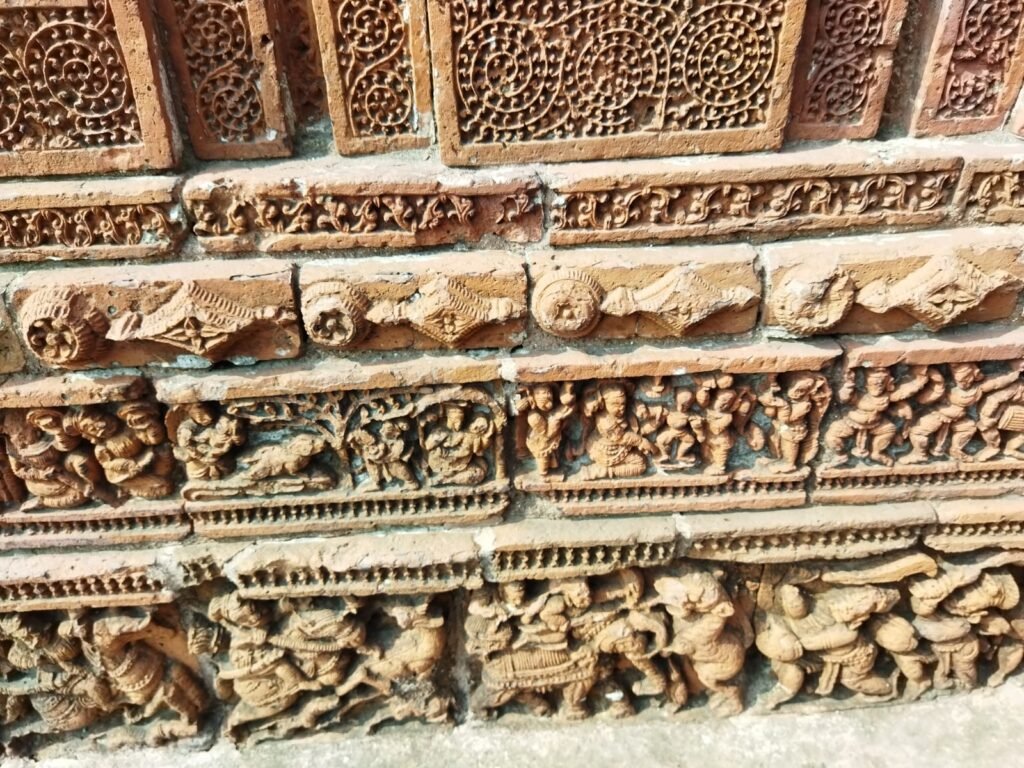
The terracotta work on the temple wall reflects the lifestyle, customs of the then society, battles, transportation, mythology, music, animals, different gods, the merriment of children, etc.
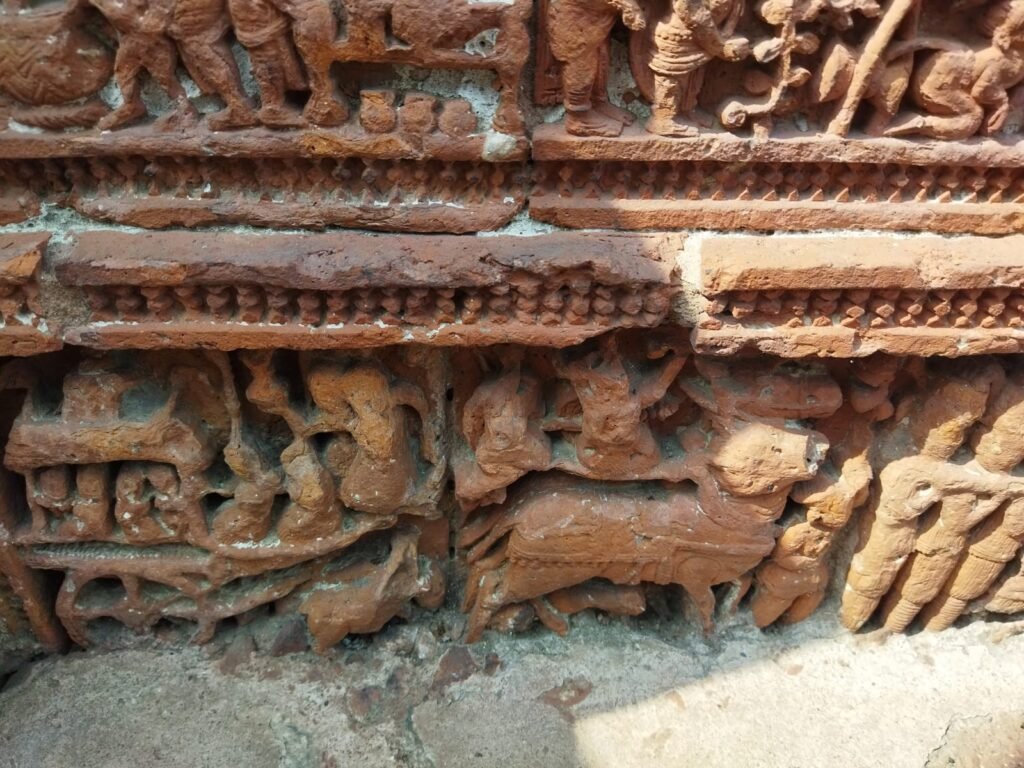
I happened to meet one Himadri from North Kolkata at Adinath temple. Himadri is a handicraft expert and is well versed in terracotta work. He nicely explained to me the terracotta work.
“Each small block of the wall reflects a different story. Yet, on the surface, all the blocks appeared as if identical. Still, it is not so, a closer look makes you comprehend that the lower block represents contemporary stories, but the upper block is all religious-related,” Himadri explained.
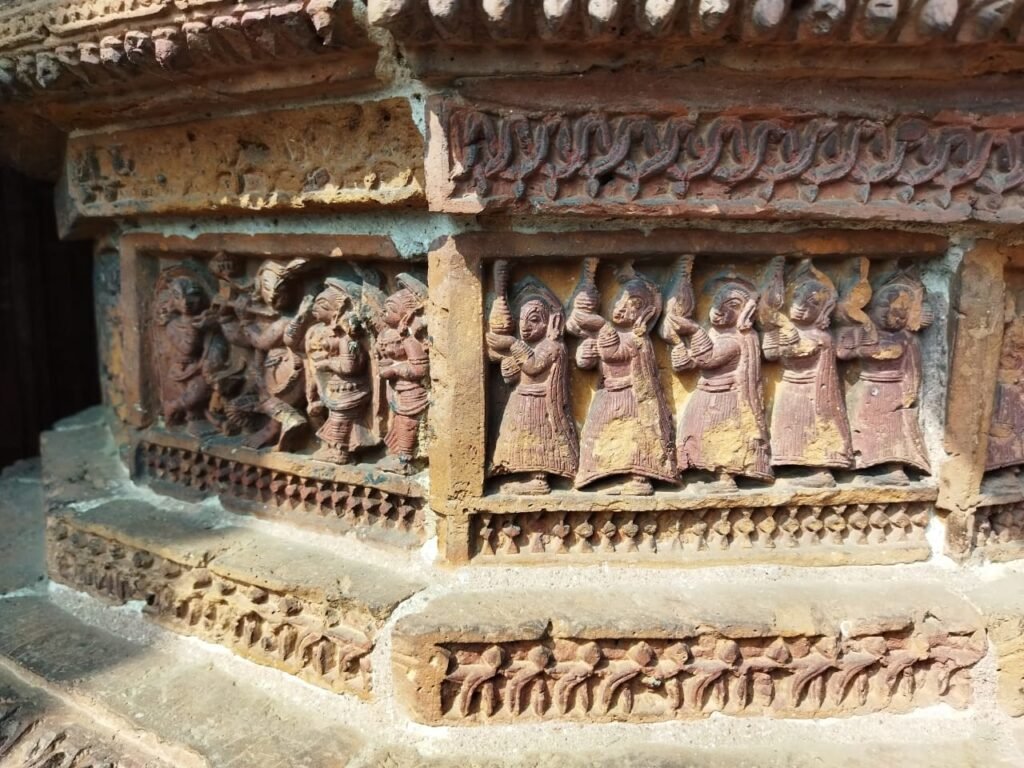
The plunderer stole the shiny black stone original idol of Lord Vishnu in 1961. The present royal family donated the new image, said priest Basudev Chatterjee.
.
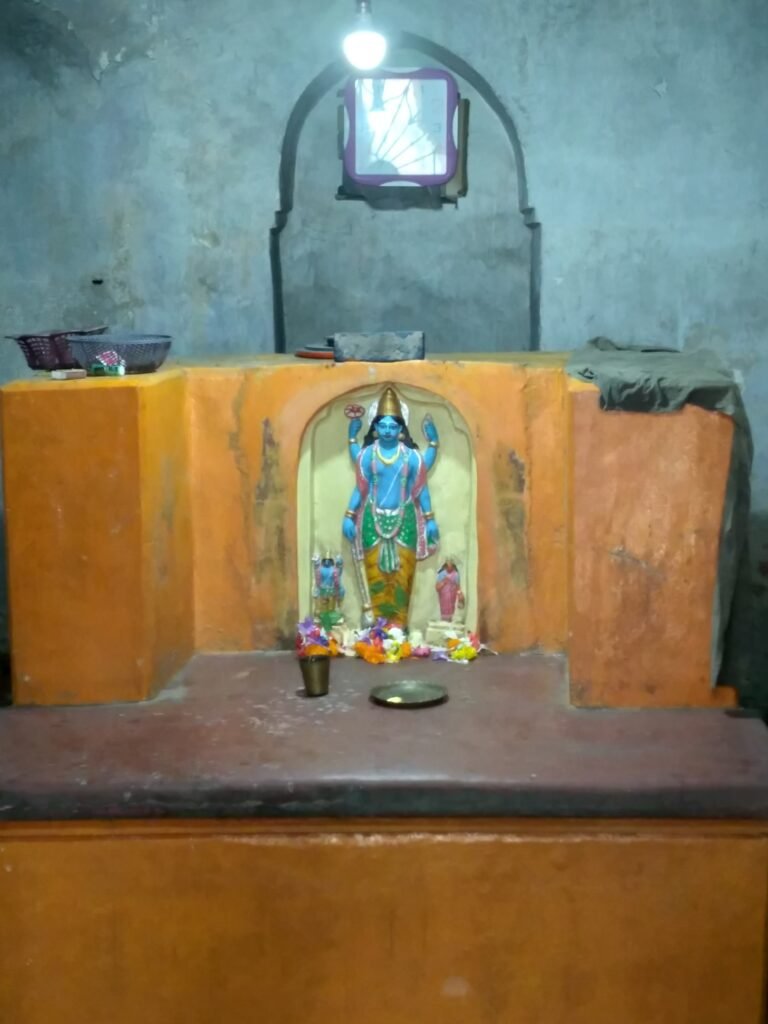
CURRENT STATUS OF ROYAL FAMILY
However, most of the current members of the royal families stay away from the town. Currently, hardly 2-3 members live in Rajbari in Hanseswar temple’s vicinity. The local people said they preferred to avoid public glare and barely interact.
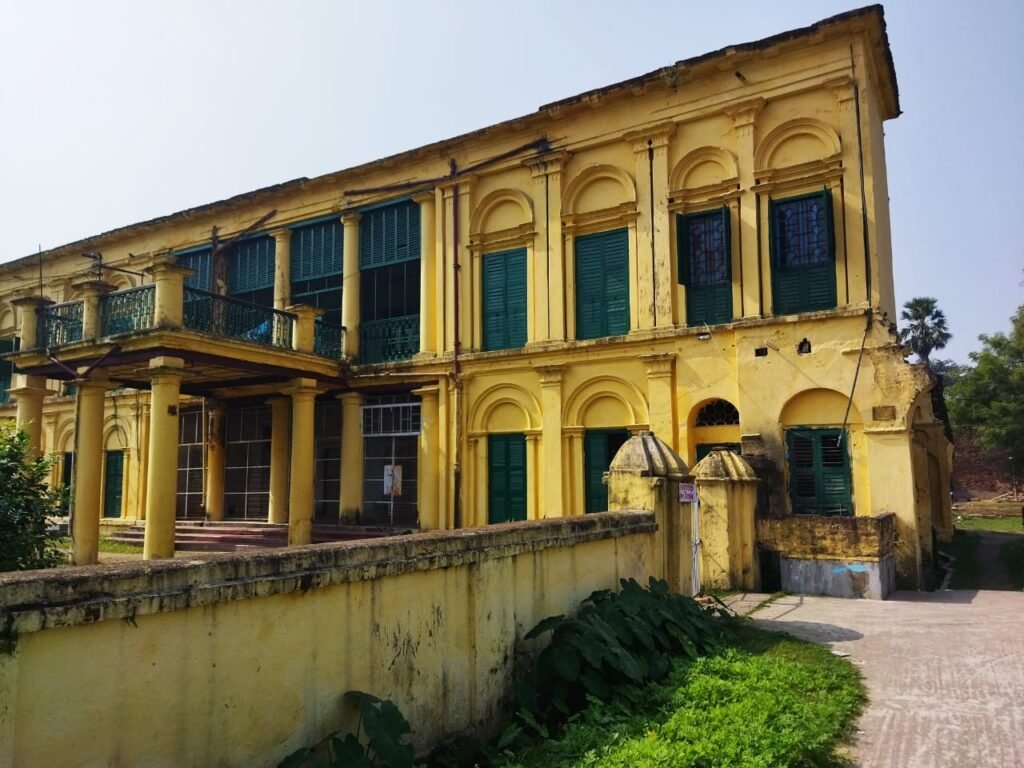
Local people said that two brothers, viz Dhrubendra Debroy and Kanakendra Debroy, fifth descendent from Nrisinghadev, resided in the Rajbari adjacent to Hansesweari temple. At the same time, most of the current generation stay out of Bansbaria. But many of them come during Durga Puja and other occasions. Both Dhrubendra and Kanakendra took a keen interest in all activities until they were alive. But both are passed away. Then son Kunalendra took over. But he too is no more. Presently three royal family members live here. Amongst three members are Mr. Kunalendra’s wife, their daughter, and Mr. Dhrubendra’s wife (Refer to the family tree at the end of the text). The majority of the house is given on rent.
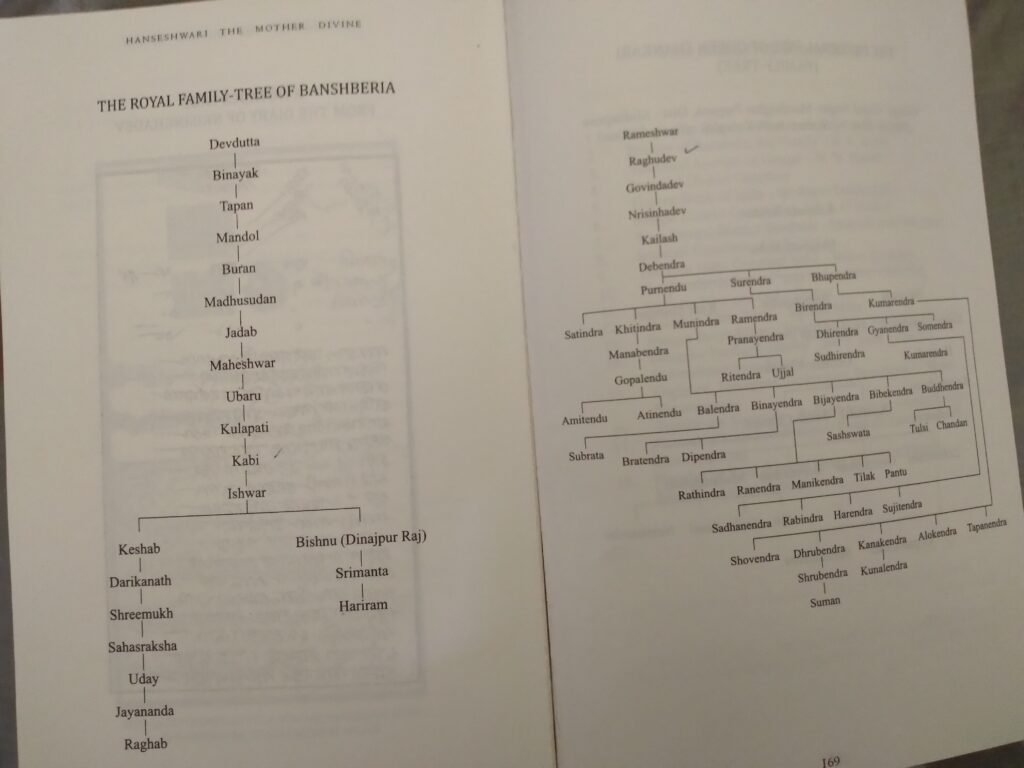
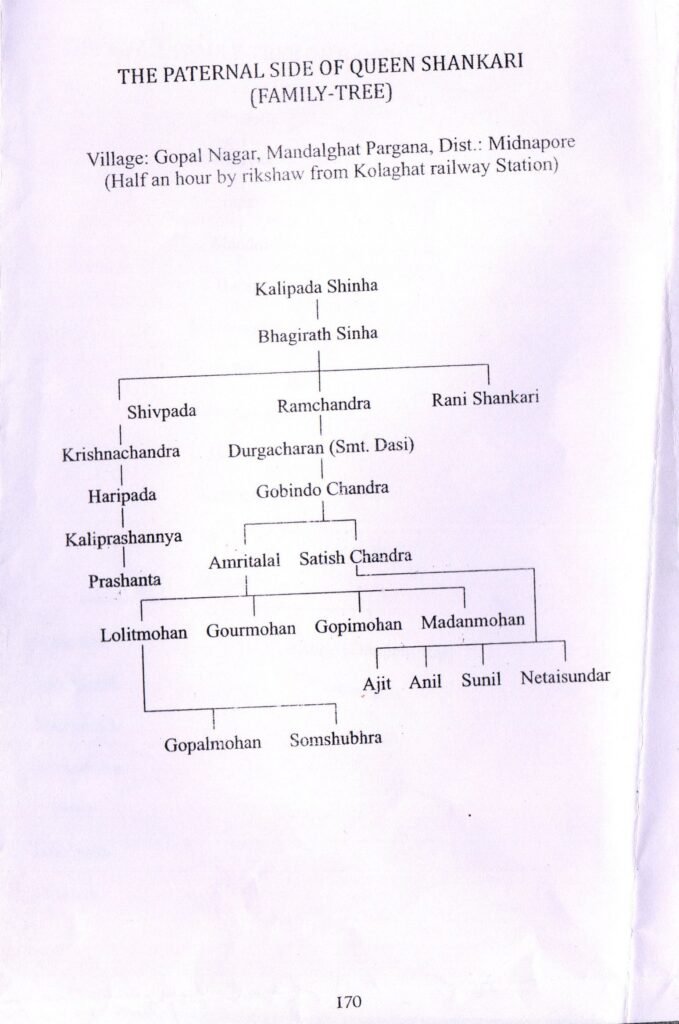
A brief background of Zamindars of Banshabati/Patuli
Incredibly impressed with the performance, the contemporary Mughal emperors conferred titles like Raja Mahashai, Ray, or Mazumdar to the zamindars of Patuli/Banshabati. The eldest son of the posterity inherited these titles.
Govindadev Roy’s generation belonged to the Patuli of Burdwan, but his grandfather (great grandfather of Raja Nrisingadev). Rameswar Ray shifted permanently from Patuli to today’s Bansbaria and established the estate named Banshabati. But after that, Zamindari related to Patuli regarding Rameswar Ray came to an end. Bansbaria was then a dense jungle of Bambo trees, and it was a den for wild animals in those days. The place had a deserted look. After the establishment of Banshabati, the area gradually became civilized. The name ‘Bansbaria was probably derived from Banshabati. In English, ‘Bansh’ means bamboo
It is also worth mentioning here that the royal family of Bansbati has its origin from Dev Dutta, a resident from Kannauj in Uttar Pradesh. Dutta was thus the surname of this royal family. (refer to the family tree given above)
Dev Dutta came to Murshidabad in Bengal with the whole family, invited by King Adisur of Bengal.
History says that king Adisur ‘a Hindu king brought in five Brahmins in the 11th century AD(later known as viz Mukherjee’s, Chatterjee’s, Banerjee’s, Ganguly’s and Bhattacaharjees) and their five attendants (represented Kayastha community viz Bose, Ghosh, Mitra, Guha, and Dutta) from Kannauj. The Dutta clan refused to remain as an attendant of Brahmans and settled down at Murshidabad by constructing their dwelling named Dattabati.
Banshabati/Patuli royal family was an offshoot of the Duttabati family of Dutta’s in Murshidabad. (refer to the family chart given above).
Route direction for Hanseswari temple.
By Train :From Howrah station, take a Katwa bound local train and get down to Bansbaria station. From there, ‘Hanseswari is hardly 1 KM. So you can take a Toto to reach Hanseswari temple.
From Sealdaha station :Catch any Kalyani bound local train, get down at Kalyani station. From there take a bus or taxi for Bansbaria to reach Hanseswari temple
By Road:
If you go by car or bike from Howrah or Kolkata, take the national highway no. 6, reach ‘Dankuni via Vivekananda Sethu, and drive straight to Bansbaria along Delhi road.
Time Of Visit
The temple remains open from 6 am to 12.30 pm, again from 4 pm to 630pm
Time for Pushpanjali: 11.00 am
For Anno prasad: Coupon to be collected by 10 am and Anno prasad is distributed from 12.45 pm
Main festivals: Snanyatra in June (Foundation day) and Dwipanwita in Kalipuja in November.




































